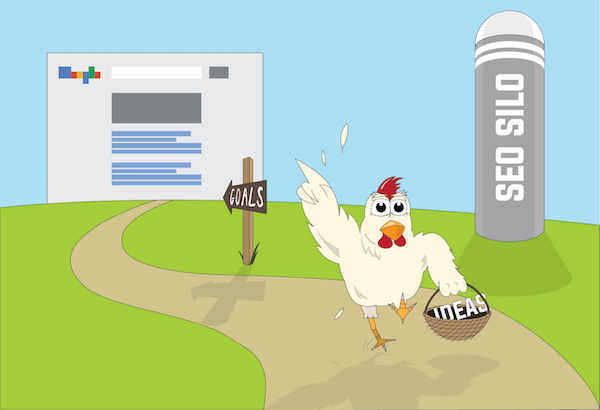
Get SEO Out of the Silo
Beginning a website redesign project can be a daunting task. And if you’re not careful, you’ll have chickens running every which way carrying wicker baskets of ideas that don’t carry out the overall website goals.

Sometimes what starts that disconnection is leaving search engine optimization (SEO) on the backburner at the start of the web project.
At the heart of any website is its balance of user-friendliness and engaging content for humans, paired with high quality, topical content for search engines to index. In essence, content. At the end of the day, what’s the benefit of a website that can’t be found when searching and doesn’t give an exceptional user experience?
This means it’s time to get SEO out of the silo and to integrate it with every team working on the redesign.
A well-optimized site doesn’t just happen magically. Start with a “Center of Excellence” for all teams to identify with—that means understanding website goals and expectations. A competitive analysis can break the ice on where to start, and then the SEO strategist should work with all teams throughout the build of the site.
Consider the basic web team below and how to ruffle SEO out of its silo.
CONTENT
A website redesign should start with a content strategy. While we don’t know exactly how content is scored, best practices show that content needs to be of high quality, which means proper time should be devoted to writing. The Google Panda algorithm update continues to punish sites with low quality, thin and duplicate content. This isn’t to say that writing a novel on every page is the answer, but it at least tells us that a single paragraph won’t optimize well.
Pages should be focused on a keyword, but also many versions and synonyms of that keyword. Leaving a page to target only one keyword without variations will result in keyword stuffing. An SEO can help the writers format their writing to include headings (H1s and H2s) as well as writing meta data such as title tags, meta descriptions, meta keywords and alterative text.
USER EXPERIENCE (UX)
Once a content strategy is decided upon, the structure of the site can start to develop. The site navigation will need to be created before content writing can start, but both the SEO and UX designer can work together to determine the flow of page hierarchies and categories of content. Once that is complete, the UX designer can start to sketch out high-level wireframes for the site, making note of where content will be placed. Things must make sense to both the user and search engine crawlers indexing the pages.
UX can also be revisited after a beta launch. Does the site do what it was meant to—that is, convert users? Elements should be revised as needed to improve UX.
DESIGN
The visuals of the website are usually the most fun part for the client to review. But I always recommend waiting until key page templates are written before jumping into design. This typically includes the home page, contact page, and two or more interior pages.
That’s because design should be centered on content. Since search engine crawlers can’t “see” the page design, it’s very important that your website content is tagged and laid out appropriately. Content must be given the space and hierarchy it needs for the crawlers to properly understand and then index your site, as well as to help users make sense of your website’s main topics. Users should know exactly where their attention is needed, and then be able to perform an action based on the conversion you are seeking.
Once the design strategy for content is figured out, your designer can have fun with creating components of the site that are user-friendly and current with today’s web design trends.
PROGRAMMING
The project manager on the web redesign should keep all pieces of the project organized for the programming team to begin work. Programming is the stage where all of these parts come together and make a living website.
Code needs to be well written and adhere to search engine crawling best practices. Meta data should be entered for all pages. Structured data such as schema mark-up or microdata should be formatted into HTML to help search engines more deeply understand the page content and properly display search engine results. By including this markup in your code, you’re basically giving more description to your website content by saying, “Ok crawlers, this title represents a movie, place, or person.”
Today’s designs have endless possibilities, and that can affect your website speed. Programmers need to develop sites with fast page load times for both bots and people.
Lastly, if you are redesigning your site, you’ll likely have a new URL structure, and that means you’ll need a redirect strategy. Each old URL should be 301 redirected to the appropriate and relevant new URL.
Communication is key. If you integrate SEO into each team, you’ll break down the silo and create a better website. Don’t forget that SEO is an ongoing process and must be monitored as you continue to make changes to your site.
Special thanks to Kevin Fish for designing the graphic for this post.



